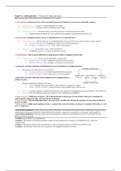Samenvatting
Summary IB Chemistry Topic 8: Acids and Bases
- Vak
- Instelling
- Boek
Detailed objective-by-objective summary notes for Topic 8: Acids and Bases for IB Chemistry SL/HL. Contains information on everything you need to know according to each understanding, application or skill. Written by a IB HL Chemistry student who graduated with a 45/45.
[Meer zien]




